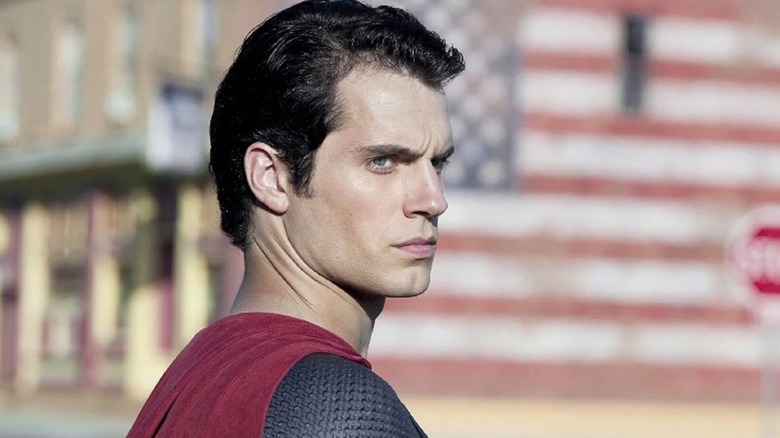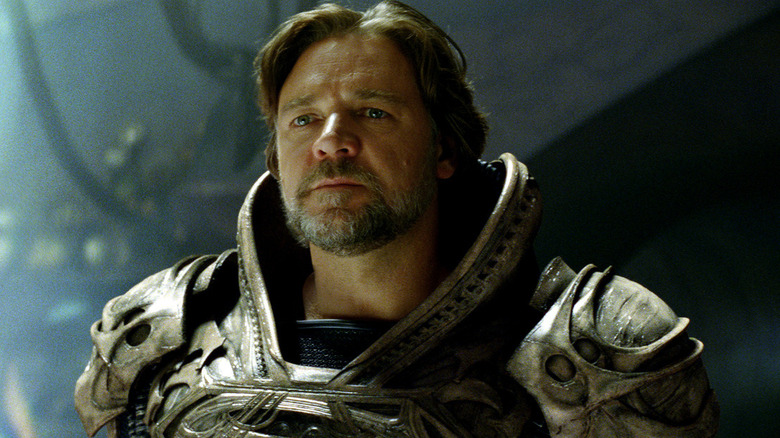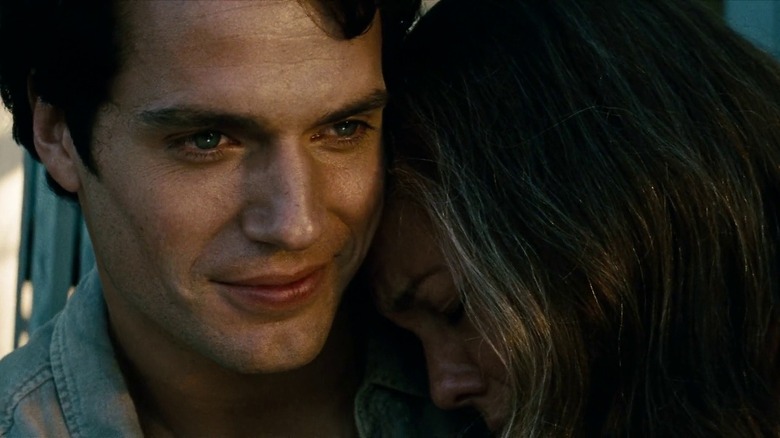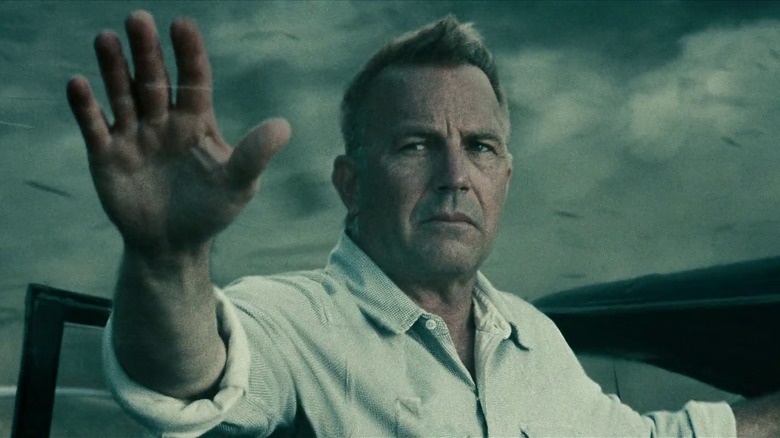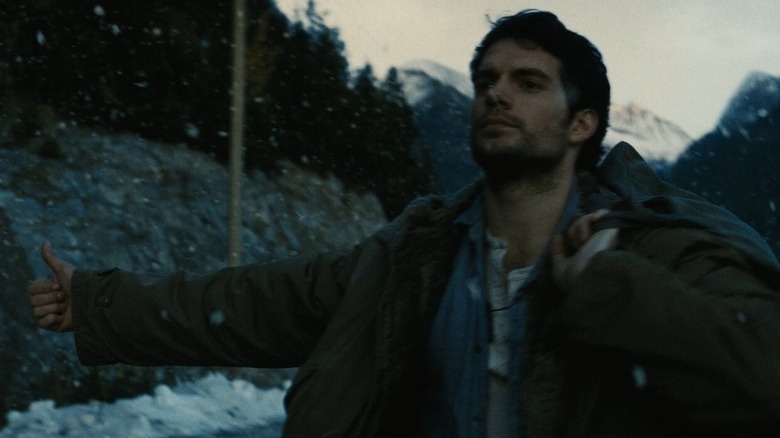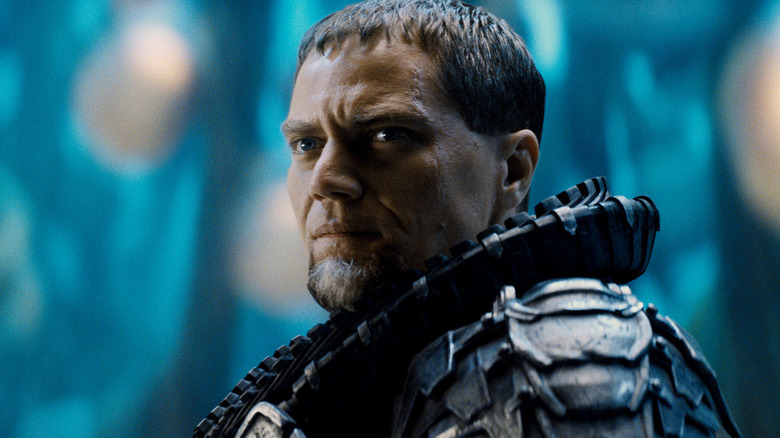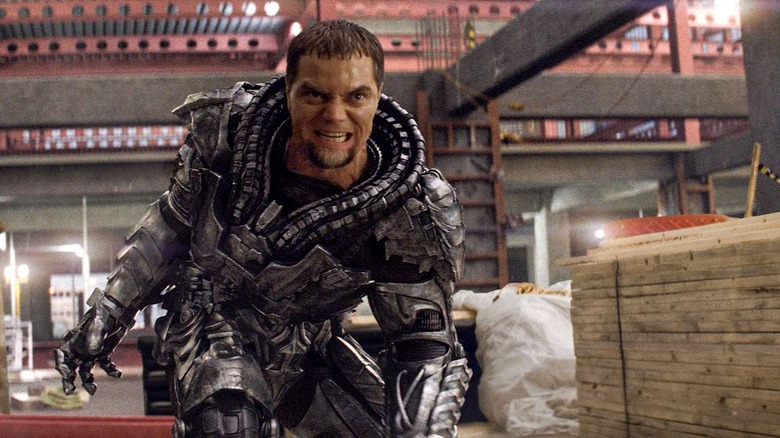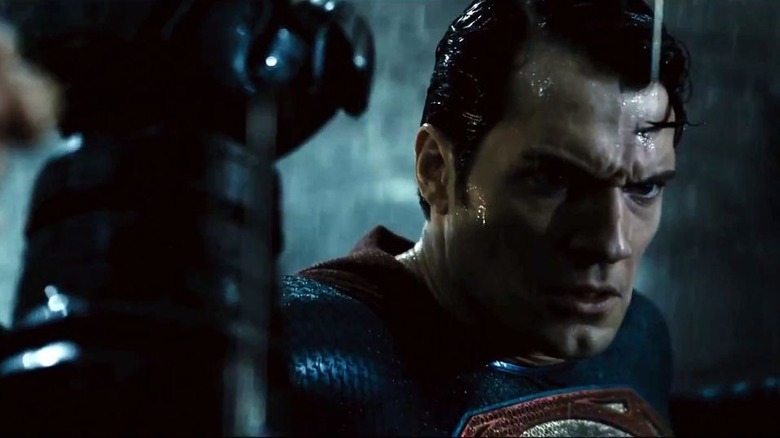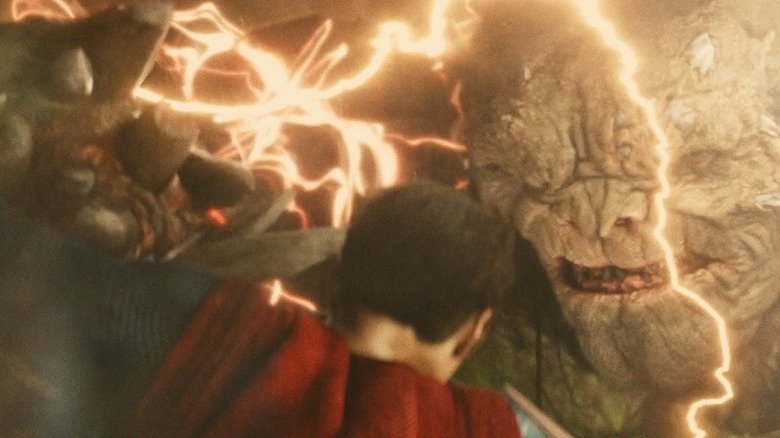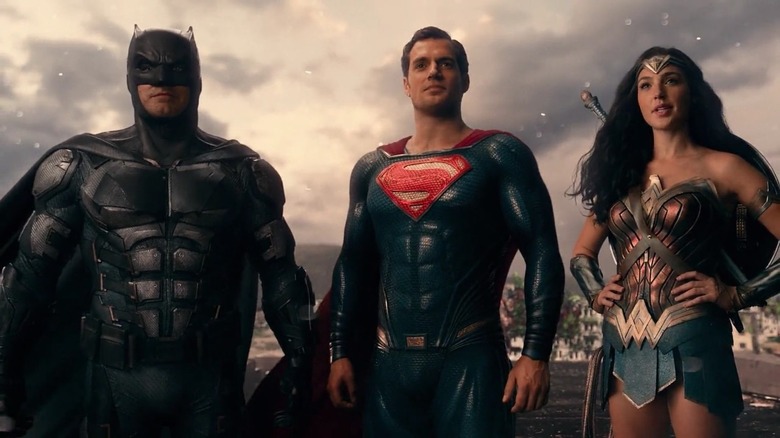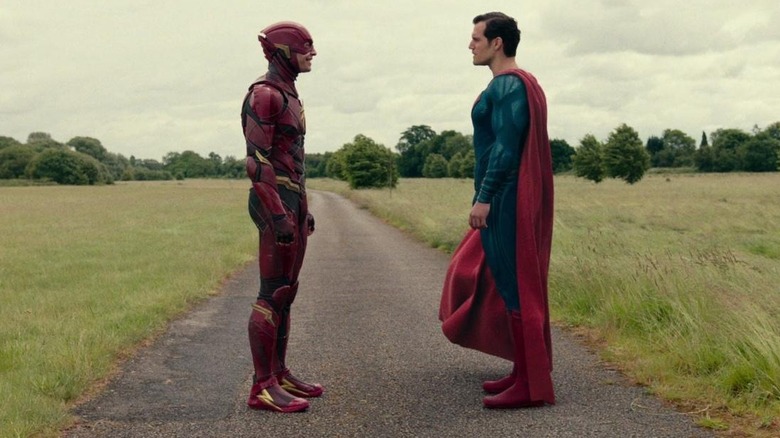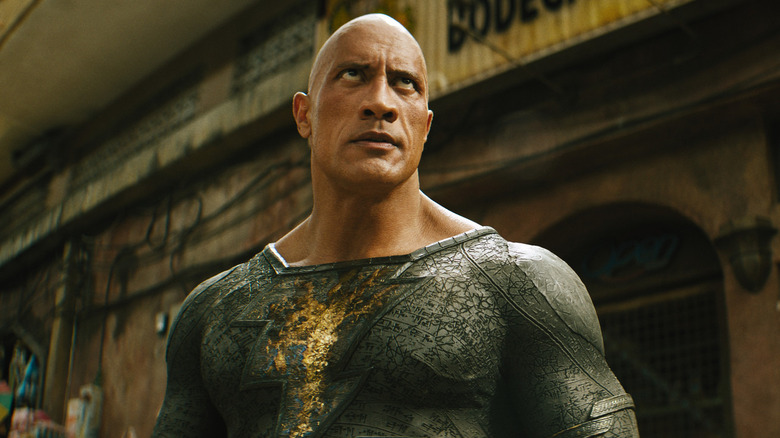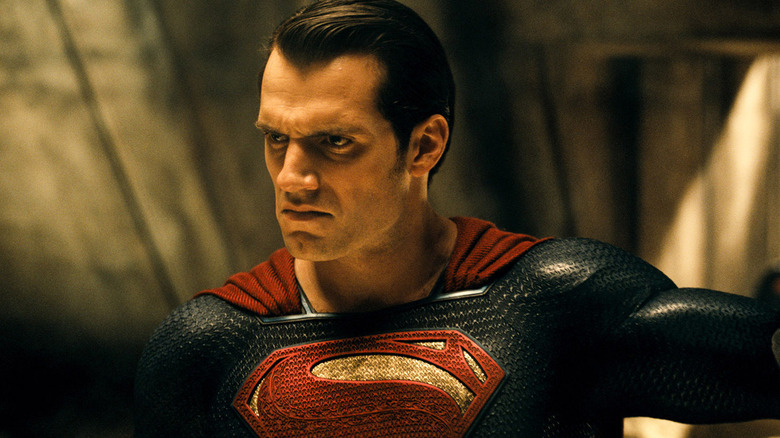The Entire Timeline Of Henry Cavill's Superman Explained
Lots of factors led to the production of Zack Snyder's tepidly-received 2013 Superman film "Man of Steel," starring Henry Cavill as the iconic superhero. After 1987's " Superman IV: The Quest for Peace" flopped, Warner Bros. spent many years working on a Superman reboot — at one point developing the Tim Burton-helmed "Superman Lives" starring Nicolas Cage as the eponymous hero (via Variety).
The studio eventually released "Superman Returns" in 2006, but that film was unfortunately deemed by fans to be too reverential to the original '70s films. But the superhero movie landscape was changing. A year earlier in 2005, Christopher Nolan's "Batman Begins" had come out to massive critical and commercial success, which led to the highly-influential "Dark Knight" trilogy. And Marvel proved that a cinematic universe format could be enormously successful, with the first phase culminating in "The Avengers" in 2012 — just one year before Superman would return again.
To compete with the ascendant MCU, Warner Bros. and DC rushed to greenlight a new Superman film to kickstart their own DC Cinematic Extended Universe (DCEU). According to Vulture, they tapped Christopher Nolan to initially shepherd the project, but he gave the reigns of "Man of Steel" to Zack Snyder, due to the director's success with comic book projects like "300" and "Watchmen." Snyder then cast the aforementioned Henry Cavill, who eventually became the fulcrum point for the DCEU's dark, winding, and confusing road to the "Justice League" (including a controversial director's cut), as well as its eventual demise. Here's the entire tumultuous timeline of Henry Cavill's Superman explained.
The Fall of Krypton
Unlike some superheroes, Superman's origin has been practically unchanged since the hero's debut in 1938's "Action Comics #1." The details of Superman's origins sometimes shifted over the years, but the basic gist has always been the same. Krypton is a technologically advanced world but is about to explode and kill everyone living on it. Jor-El is a top scientist on Krypton who builds a rocket to send his human-looking son Kal-El to Earth to keep him out of harm's way. Some variations include Kal-El being suspended in a birthing matrix on the rocket before crashing so that he could technically be born on Earth, such as in John Byrne's post-Crisis origin.
This is true of the film "Man of Steel" as well — which likely borrowed its name from the aforementioned '86 Byrne run, though Superman had that nickname as early as 1938's "Action Comics #6." Jor-El — played in the film by Russell Crowe — informs the Krypton high council that due to them mining the planet's core, it's about to explode with no time to evacuate. Though Jor-El and his wife Lara Lor-Van (Ayelet Zurer) successfully send Clark to Earth, Jor-El is killed by General Zod (Michael Shannon), who was attempting a military coup on the planet at the time. Later, the planet inevitably explodes and Superman's home planet is destroyed.
Kal-El crashes in Smallville and is raised by The Kents
When Jor-El and Lara Lor-Van sent their young son Kal-El to Earth, Jor-El declared that "he'll be a god to them." Like all other Superman stories, Kal-El's rocket crash lands somewhere in the fictional small rural Kansas town, aptly named Smallville. There he is discovered by a kindly married farm couple named Jonathan (Kevin Costner) and Martha Kent (Diane Lane).
Unlike Richard Donner's 1978 "Superman" film, Zack Snyder's "Man of Steel" is told non-linearly — similar to what Christopher Nolan did with Batman's familiar origins in "Batman Begins." This means we don't actually see the Kents discover Kal-El or the rocket, but it is alluded to. At one point, a young Clark Kent (Kal-El's human name) saves a bus that falls off a bridge into a river by pulling it to safety with his super-strength. However, he is admonished by his adopted Earth father when word of this good deed gets out. Jonathan tells Clark that he's got to keep himself a secret and that he isn't supposed to help people because they might be afraid of his powers. Martha, meanwhile, becomes more pivotal to Clark's upbringing — to the point that she becomes central to the plot in the 2016 sequel "Batman v Superman: Dawn of Justice." We see hints of this in "Man of Steel," when she's able to calm Clark's super-senses with just her calming voice.
Jonathan Kent sacrifices himself to protect Clark's identity
"Man of Steel" does take a few liberties with the established Superman lore. One of the biggest changes is Zack Snyder's take on Superman's adoptive father, Jonathan Kent. In most versions of Superman's origin, Jonathan Kent is alive throughout Clark's adult life — up to seeing Clark become Superman. In "Man of Steel," however, he is killed by a tornado while Clark is still just a teenager, willingly sacrificing himself to protect Clark's identity.
One of the main themes of "Man of Steel," is the question of whether the human race is even worth saving. This is shown throughout the film with Clark being bullied, being tempted by Zod to repopulate the Earth with the Kryptonian DNA in Clark's blood, and eventually being distrusted and even imprisoned by the military. This all seems to prove Jonathan Kent's suspicions about how humans on Earth would respond to such a powerful being while Clark is in full Superman mode. So Jonathan does what he thinks is best for Clark at that moment — letting himself die rather than Clark show off his super-speed and reveal his true identity. This tragic event obviously has a profound impact on Clark into his adulthood.
Adult Clark Kent becomes a drifter
After an unspecified amount of years following his father's death, Clark Kent goes out on his own to find himself. Jonathan Kent had told him that whatever man he chose to be, he was "gonna change the world" and it's unclear at this point if Clark is trying to escape his destiny, or trying to discover what his destiny actually is. However, it seems to be the former, as he later tells Lois Lane (Amy Adams) how his father was afraid the world would reject him if he revealed himself and his true powers and that this fear had now passed onto him and made him want to turn his back on his destiny.
So, when we first see Clark as an adult, he's struggling as the new guy on a fishing boat. Afterward, we see him as a bartender where he has to stop himself from attacking a surly trucker. Finally, Clark works as a courier on a Canadian military base, where the Canadians and the United States government are studying a Kryptonian ship that crash-landed on Earth centuries earlier — unrelated to Clark or Zod. As Clark sneaks into this old Kryptonian ship, this is also where he meets and saves Lois Lane, who is reporting on this expedition.
General Zod discovers Earth and challenges Clark
During the final days of Krypton — once political malfeasance had led to its destruction through carelessly over-exploiting its resources — General Zod attempts to take over the planet with a military coup in a misjudged effort to save it. Standing in Zod's way is Jor-El — who apparently was a former ally and close friend of Zod — and who thinks that Zod's insurrection is a waste of time. Jor-El instead put the genetic material of all Kryptonians — who are at this point being born in test tubes — into the blood of his son Kal-El, who was the first to be naturally born on Krypton in centuries. And, while Jor-El is successful in launching Kal-El's rocket toward Earth, Zod kills him — one of the other changes from the original origin, as Jor-El usually dies along with the exploding planet.
Zod's insurrection eventually fails, though, and Zod and his fellow conspirators are sent into the Phantom Zone before Krypton's ultimate destruction — but not before Zod vows to find Jor-El's baby. Once Krypton is destroyed, however, the explosion sends Zod and his soldiers out of the Phantom Zone, and drifting through space for years. Back on Earth, Clark discovers the old Kryptonian ship that was sent prior to Kal-El's, and accidentally sends a beacon to Zod's prison vessel, leading it — and Zod — straight to Earth.
Superman fights and kills General Zod
General Zod only has one goal in mind throughout "Man of Steel" — to create a New Krypton. In fact, the whole reason he enacted his initial military coup against the Kryptonian high council in the first place was because he felt that their leadership was responsible for the destruction of his beloved home planet. When it's discovered that Jor-El had put the genetic codex of all Kryptonian DNA in Kal-El's blood — enough to repopulate the entirety of Krypton if extracted — he captures Superman and tells him of his plan. Worse, Zod wants to also use a machine called a "World Engine" against Earth — which had been used previously by the Kryptonian colonists to terraform other planets. Superman obviously can't allow that, so Zod and Clark fight in a long, drawn-out fight in downtown Metropolis — toppling a number of buildings in the process. Eventually, Zod threatens to kill an innocent family with his laser vision, and Clark has no choice but to snap Zod's neck and kill him.
Screenwriter David S. Goyer stated in a panel with Backstory Magazine that this scene was to explain why Superman has an aversion to killing. While there is some comic book precedence of Superman killing Zod, it does seem strange that there wasn't another solution Superman could've come up with — particularly when the fight with Zod saw so many innocent lives lost in Metropolis.
Superman fights Batman and is defeated
In the action-packed climax of "Man of Steel," it is hard to ignore that the fight between General Zod and Superman in the middle of Metropolis caused untold levels of destruction and civilian deaths — so much so that it actually turned some fans off of the film. The filmmakers seemed to take that criticism to heart and used the crossover sequel "Batman v Superman: Dawn of Justice" to directly address the destructive final battle of "Man of Steel." At the beginning of "Batman v Superman" — after a lengthy re-introduction of Batman's origin — we see an adult Bruce Wayne (Ben Affleck) witnessing the destruction of the fight between Superman and Zod firsthand.
This leads to Bruce gaining an unhealthy obsession with the Kryptonian superhero, and he steals Kryptonite from Lex Luthor (Jesse Eisenberg) so that he has a weapon to use against him. He puts on a Frank Miller-inspired metal armor suit and decides to challenge and fight Superman in an abandoned building in Gotham. While they're evenly matched for a while, Bruce had manufactured Kryptonite smoke bombs to weaken Clark's superpowers, and he's able to subdue and almost kill Clark. The only reason he doesn't is that Luthor had kidnapped Clark's mother earlier — having learned both their secret identities — and he tells Batman, "save Martha" — which was also Bruce's mother's name. Improbably, this snaps Bruce back to reality, having now apparently seen Superman's own humanity — and an opportunity to metaphorically save his own mother.
Superman is killed by Doomsday
Like most comic book fights between two good guys, the climax of "Batman v Superman: Dawn of Justice" eventually leads to Batman and Superman teaming up against the true enemy of both of them, Lex Luthor. The baddie had apparently found Kryptonite in the Indian Ocean — due to one of Zod's "World Engines" being stationed there — and that was the same Kryptonite that Batman stole to fight Superman with. However, it wasn't just Kryptonite that Luthor had access to — he also possessed Zod's dead body and a Kryptonian birthing chamber. Once it becomes clear that Luthor plans to have Batman kill Superman for him, the corrupt CEO then decides to use the aforementioned birthing chamber to resurrect Zod's corpse into a giant, gray-skinned, hulking monster, which Luthor dubs Superman's "Doomsday."
This plot calls back to "The Death of Superman" story from 1992, which was about the titular hero's demise. And while the comic's depiction of Doomsday is quite different from the film, his basic narrative function is the same and he kills Superman. This devastates everyone, including Batman — despite the pair going toe to toe only a few hours ago — and Wonder Woman (Gal Gadot) who showed up at the end to join the heroes against Doomsday. Unsurprisingly, the person most wounded by Superman's death is Lois Lane, who discovers from Martha Kent that Clark had planned to propose to her.
Superman is resurrected by the Justice League
At the beginning of 2017's "Justice League," we are reminded that Superman is still dead and buried. Furthermore, it seems the world has gone to Hell in the interim with a tragic montage showing that crime has increased in the absence of the Man of Steel. Batman has also turned over a new leaf after his interactions with Superman, with his sacrifice against Doomsday giving The Dark Knight hope for the world again. Batman then finds out that there's an inter-dimensional threat to Earth, headed by the evil Steppenwolf (voiced by Ciarán Hinds) — who himself is under the employ of the powerful despot Darkseid. Batman and Wonder Woman attempt to recruit other metahumans to quell Steppenwolf's invasion, which includes Aquaman (Jason Momoa), Cyborg (Ray Fisher), and The Flash (Ezra Miller). Unfortunately, not all of the heroes show willingness and only the enthusiastic Flash agrees to join them.
Even more unfortunately, they can't stop Steppenwolf, so the only option is to combine their forces to dig up Superman's body, put the corpse in the Kryptonian birthing chamber, and resurrect the hero. This initially works, but he's disorientated and goes on the offensive, taking on the entire group of superheroes single-handedly. It's not until Batman brings in Lois Lane that Superman is able to calm down and stop fighting them.
Superman joins the Justice League
After his dramatic reawakening, Superman spends time on his childhood farm with his mother and Lois Lane where he comes to his senses and regains his love for Earth and humanity again. Afterward, he immediately decides to re-don his blue-and-red superhero costume and fly towards Chernobyl — where Steppenwolf and his Parademon army have set up shop — to stop them from connecting three Mother Boxes together and destroying the world. As he arrives, the other Justice League members are at their wit's end, and almost lose. Luckily Superman flies in and pummels Steppenwolf into submission. Then, after saving some Russian civilians in the nearby area — with Superman carrying an entire building to safety — he helps Cyborg separate the Mother Boxes and save the day.
The film ends with Batman buying back the Kent farm — which had been foreclosed in the interim — and Superman joining him and Wonder Woman at the old, devastated Wayne Manor. This was presumably poised to become the new Hall of Justice headquarters for future "Justice League" sequels, but these never came and are unlikely to at this point (via The Hollywood Reporter). The final shot of the film sees Superman and The Flash racing towards the screen, in a recreation of an iconic comic book cover where they compete to determine the fastest man alive.
Superman becomes a government lapdog in Black Adam
Presumably the last time we'll see Henry Cavill's version of Superman — save for some possible multiverse shenanigans — is an after-credits stinger in 2022's "Black Adam," starring Dwayne Johnson as the eponymous super-powered anti-hero. At the end of the film, Black Adam is sitting on his throne and is visited by a high-tech drone projecting a hologram of government agent Amanda Waller (Viola Davis).
Waller mentions that since Black Adam was able to successfully fight off the Justice Society of America, he'll be allowed to remain as the protector of Kahndaq — the fictional Middle Eastern nation-state that Adam calls home. However, Waller states that he is confined there and that it is essentially his prison. When he replies that no one in his world can stop him, she says that she can call favors from people from other worlds. In anger, Adam lightning bolts the drone causing it to explode.
Cue a burst of John Williams' classic Superman theme, and Cavill walks out of the smoke from the destroyed drone, stating, "It's been a while since anyone's made the world this nervous." In what should've been a really thrilling moment for fans, it's a little disappointing to see Superman become a government stooge like this. When he was depicted this way in Frank Miller's seminal 1986 graphic novel "The Dark Knight Returns," it was supposed to show how dystopian the world had gone, but this brief glimpse doesn't seem to reflect that.
He might become a super-dictator in the post-apocalypse
While Henry Cavill's last appearance as Superman is in the "Black Adam" post-credits sequence, it's not the last time his Superman is seen in universe. In fact — according to an alternate near-future — Superman will become an evil enforcer for the despotic Darkseid after the unfortunate death of Lois Lane. As far as we can tell, this future is only a vision that Batman was accidentally shown by a time-traveling Flash — who is distraught that he arrived "too soon." The ensuing vision seen in "Batman v Superman: Dawn of Justice" — dubbed "The Knightmare Sequence" – shows Batman wearing a brown trenchcoat over his dark rubber costume, and then being taken prisoner by an army of Parademons and fascistic Superman followers.
Later, Superman flies in angrily, killing everyone with laser-eye blasts, then punching Bruce through the chest. This possible future is then expanded upon in the "Snyder Cut." As well as Cyborg witnessing Superman's turn at the hands of Darkseid while connected to the Mother Boxes, there's also an entirely new sequence tacked on at the end — reportedly the only new footage filmed (per IndieWire). It's similar to the aforementioned "Knightmare" sequence, only now Batman is joined by a Mad Max-esque Flash, Cyborg, Mera (Amber Heard), Deathstroke (Joe Manganiello), and a tattoo-less Joker (Jared Leto), who are then attacked by a vengeful and evil Superman.
